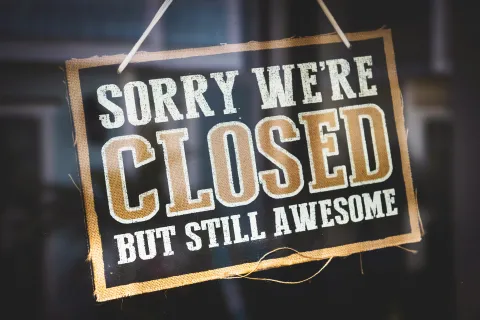Perception vs. reality: The truth about lost opportunities after business closure

What is the worst case scenario for a budding entrepreneur’s new business? With news in 2023 about Bed Bath & Beyond’s bankruptcy, as well as store closures from Walgreens, Footlocker, and more chains all over the US just last year, your answer might be business closure. You might also blame their fate on negative performance or trends like economic downturns or problems with demand and production of items. However, research from Jessica Santana (Assistant Professor, Technology Management at UCSB) shows that more stable, often immutable factors like gender and region, which come into play even before a business has started, can contribute just as heavily to the causes and effects of that business’ eventual closure.
Santana’s research pulls from the idea that business closure should not be intrinsically tied to negative reasonings or outcomes. Business closure can just mean that an entrepreneur has moved on to a new stage of their life, such as retirement, or that they plan to use the money they’ve made for some alternative goal or to fund a new profession. Positive closures differ from their negative counterparts because they are chosen voluntarily by the entrepreneur, and thus don’t lead to emotional, financial, and social costs. Business closures like this shouldn’t mean an entrepreneur can’t be successful moving forward, and should be factored into that closure’s perception by wider society. The circumstances surrounding a business closure and the closure’s impact are just as important, if not more important, than the closure itself.
To support this claim, Santana compared the demographics of positive and negative business closures to make observations about the relationship between contributing demographic factors and entrepreneurial outcomes. Her study pulls data from the Global Entrepreneurship Monitor’s annual Adult Population Survey that asked adults from multiple countries if they had closed a business within the last 12 months, and if so, what their reason for doing so was. From this data, Santana made several important findings. For one, the likelihood of a positive business closure increased when the entrepreneur did not fear failure. Being female decreased the odds of a positive closure by 20%. Likewise, being an entrepreneur from outside of the US decreased the odds of a positive closure by more than 50%. In terms of starting a new business after experiencing failure, female entrepreneurs were 24% more likely to avoid starting over out of fear of failure, and entrepreneurs outside of the US were 54% more likely to do the same.
While these results do not necessarily prove causation (that being female or living outside of the US leads to negative business failure or refusal to try again), what it does show is that more attention needs to be paid to business closures that fall outside of expected circumstances. Current biases can lead stakeholders and clients to hold entrepreneurs responsible for their perceived failings—refusing to give them business or offer them the same opportunities that other businesses without past closures might receive. Acknowledging that immutable factors like gender and region can affect a business’ success should open doors for more discussions and creation of more equitable practices.
3 ways you can make a difference
While an individual alone cannot change systematic biases, we can help by consciously making our own decisions on a day-to-day basis and in the workplace. Here are a few ways that you can help:
- Research and support women-led and foreign small businesses. Each individual can play an important part in boosting morale and motivation by offering our business. Perceptions of success often lead to quantifiable results.
- Don’t let fear of failure control your results. You lose every shot you don’t make. Even if you may worry that your business—or other endeavors—may fail, keep in mind that failure can be on your terms, and that it may also come with other factors that you can’t change.
- Don’t allow bias to control your investments. Look for a second opinion or study your decision from different angles to make sure that you’re not making assumptions. You could be missing out on an opportunity with great potential.

 Instagram
Instagram LinkedIn
LinkedIn Twitter
Twitter